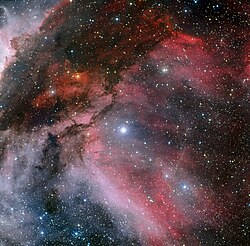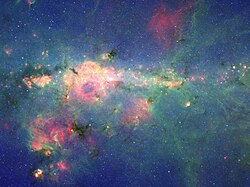List
Milky Way Galaxy
| Star system ← ← | Star Image | Median distance (ly) | Spectral type | Apparent magnitude (V) | Comments and references |
|---|---|---|---|---|---|
| Gamma² Velorum A (WR 11/Suhail al Muhlif/Regor) |  | 1096+26 −23 | WC8 | 1.83 | The Closest Wolf-Rayet star to Earth. Gamma² Velorum has a O-type companion star. |
| WR 147 A | 2,100±200 | WN8h | 13.86 + 16.02 | Has a B-type companion star. | |
| HD 45166 A | 3,232 | qWR | 9.88 | The primary of HD 45166 is currently the only known example of a qWR star and has a B-type companion star. | |
| HD 107969 |  | 3,377.2±153.6 | WC | Center star of NGC 4361 Nebula. | |
| WR 142 |  | 4,000 | WO2 | 12.94 | |
| HD 326823 (V1104 Scorpii) | 4,142 | WNpec | 9.03 | ||
| HD 151932 (WR 78) | 4,200 | WN7h | 6.45 - 6.61 | ||
| EZ Canis Majoris (WR 6) |  | 4,900 | WN4-s | 6.91 | |
| WR 144 | 5,120 | WC4 | |||
| WR 111 (HD 165763) | 5,316+320 −230 | WC5 | +7.82 | ||
| WR 140 A (SBC9 1232) |  | 5,600 ± 300 | WC7p | 6.85 | |
| HD 152408 (WR 79a) |  | 5,600 | WN9ha | 5.81-5.85 | |
| WR 93 | 5,900 | WC7 | |||
| WR 134 |  | 6,000 | WN6-s | 8.08 | |
| WR 135 | 6,000 | WC8 | 8.11 | ||
| WR 133 A (V1676 Cyg) | 6,100 ± 300 | WN5o | 6.75 - 6.84 | ||
| HD 152408 (WR 79a) | 6,500 | WN9ha | 5.81-5.85 | ||
| WR 25 A (HD 93162) |  | 6,500 | O2.5If*/WN6 | 8.80 | |
| Apep (WR 70-16) |  | 6523+400 −300 | WR + WR | ||
| CV Serpentis (WR 113) | 6,700 ± 200 | WC8d | 9.08 | ||
| WR 136 (HD 192163) |  | 6,700 ± 500 | WN6(h)-s | 7.50 | |
| WR 86 | 6849 ± 800 | WR | 9.27 | ||
| HD 192641 (WR 137) [4] | 6850+600 −500 | WC7pd+O9Ve | |||
| WR 114 | 7,200 ± 600 | WC5 | 12.02 | ||
| HD 83535 |  | 7,270 | WC3 | Central star of NGC 2867 Nebula. | |
| Theta Muscae (WR 48) | 7,400 | WC5/6 | 5.53 | ||
| WR 93b |  | 7,600 ± 500 | WO3 | 15.2 | |
| PG 1159 | 8,000 | WC | Central star of Engraved Hourglass Nebula. | ||
| WR 2 | 8,186 | WN2-w | 11.33 | ||
| WR 22 (V429 Carinae) |  | 8,300 ± 700 | WN7h | 6.42 | |
| WR 104 (V5097 Sgr) |  | 8,400 | WC9d | 13.28 + 15.36 | |
| AG Pegasi | 9,000 | WR | 6.0 - 9.4 | ||
| WR 8 | WR | ||||
| WR 46 (DI Crucis) |  | 9,300 ± 900 | WN3p-w | 10.83 | |
| WR 3 | 9,458+520 −390 | WN3-hw | 10.69 | ||
| WR 128 | 9,500 | WN4(h)-w | 10.51 | ||
| WR 102 | 9,500 ± 600 | WO2 | 14.10 | ||
| WR 138 | 10,000 | WR | |||
| WR 120 | 10,000 | WN7w + WN3/4 | 11.93 | ||
| WR 119 | 10,500 | WC9d | 12.06 | ||
| WR 1 | 10,500 ± 500 | WN4-s | 10.54 | ||
| WR 112 [4] |  | 11050+2900 −2750 | WC8-9d+OB | ||
| WR 157 | 11285.01 | WN4.5 | Member of Markarian 50 Cluster. | ||
| WR 69 | 11,350 | WC9d | 9.1 | ||
| WR 156 | 11,900 ± 500 | WN8h | 11.01 | ||
| WR 9 | 12,000 ± 600 | WC4 | 10.50 | ||
| WR 48a [4] |  | 12,400 ± 2000 | WC8d+Oe | ||
| WR 142a | 13,000 | WR | |||
| WR 21a |  | 13,100 ± 700 | O3/WN5ha + O3Vz((f*)) | 12.661 | |
| WR 138a | 13,698 | WN9h | 15.44 | ||
| CD Crucis (WR 47) | 14,000 | WN6o | 10.81 | ||
| WR 120–6 | WN4 | It is the central star of Abell 48 Planetary Nebula. | |||
| WR 24 (HD 93131) |  | WN6ha-w | 6.48 - 6.50 | ||
| WR 20a |  | 14,000 ± 1,000 | O3If*/WN6 + O3If*/WN6 | 13.28 | |
| NGC 2452 Central Star | 15,000 | WO1 | Central star of NGC 2452. | ||
| WR 142b | 15,000 | WR | |||
| WR 7 (HD 56925) |  | 16,000 | WN4-s | 11.56 | |
| M4-18 Centeral star | 17055+670 −440 | WC11 | Central star of M4-18. | ||
| AG Carinae |  | 17,000 ± 1,000 | WN11 | 6.96 | |
| WR 12 (V378 Velorum) | 19,000 ± 1,000 | WN8h | 10.78 | ||
| MR 93 (WR 125) [4] | 19200+2350 −1900 | WC7d+O9III | |||
| OAO 1657-415 | 20,000 | Ofpe/WN9 | >23 | ||
| WR 124 (QR Sagittae) |  | 21,000 ± 2,000 | WN8h | 11.50±0.11 | |
| WR 30a |  | 21,917+1,400 −1,090 | WO4 | ||
| WR 121-16 | 23,190 | WN7o/WC | 14.02 | ||
| Cygnus X-3 (WR 145a/V1521 Cyg) | 24,135±1,100 | WN 4–6 | |||
| NGC 3603-A1 (WR 43a/HD 97950A1) |  | 24,800 | WN6h+WN6h | 11.18 | Part of NGC 3603 Nebula. |
| NGC 3603-B (WR 43b/HD 97950B) | WN6h | 11.33 | |||
| NGC 3603-C (WR 43c/HD 97950C) | WN6h | 11.89 | |||
| NGC 3603 MTT 58 (WR 43-2) | O2If*/WN6 | ||||
| HD 97950 (WR 43) |  | 25,000 | WR | 9.03 | It is the central core of a super star cluster within the NGC 3603 H II region (similar to R136 within the Tarantula Nebula). |
| Arches-B1 (WR 102bc) |  | WN8-9h | Part of Arches Cluster. | ||
| Arches-F1 (WR 102ad) | WN8-9h | ||||
| Arches-F2 (WR 102aa) | WN8–9h O5–6 Ia+ || | ||||
| Arches-F3 (WR 102bb) | WN8-9h | ||||
| Arches-F4 (WR 102al) | WN7–8h | ||||
| Arches-F5 (WR 102ai) | WN8-9h | ||||
| Arches-F6 (WR 102ah) | WN8-9h | ||||
| Arches-F7 (WR 102aj) | WN8-9h | ||||
| Arches-F8 (WR 102ag) | WN8-9h | ||||
| Arches-F9 (WR 102ae) | WN8-9h | ||||
| Arches-F10 (WR 102ab) | O7–8 Ia+ | ||||
| Arches-F12 (WR 102af) | WN7–8h | ||||
| Arches-F14 (WR 102ba) | WN8-9h | ||||
| Arches-F16 (WR 102ak) | WN8-9h | ||||
| Arches-F17 (WR 102ac) | O5–6 Ia+ | ||||
| WR 42e (2MASS J11144550-115001) | O3If*/WN6 | 14.53 | |||
| G0.059-0.068 | 26,000 | B0-1Ia+/WNLh | |||
| G0.238-0.071 | WN11h | Present in the Galactic Center region of Milky Way. | |||
| WR 102ka (Peony Star) |  | 26,000 | Ofpe/WN9 | ||
| WR 102c |  | WN6 | 11.6 | Part of Quintuplet cluster. | |
| WR 102ea | WN9h | 8.8 | |||
| WR 102da | WC9?d | ||||
| WR 102dc | WC9d + OB | ||||
| WR 102ha | WC8/9d + OB | ||||
| WR 102dd | WC9d | ||||
| WR 102hb | WN9h | ||||
| WR 102db | WC9?d | ||||
| WR 102f | WC8 | ||||
| WR 102df | O6–8 I f (Of/WN?) | ||||
| WR 102i | WN9h | ||||
| WR 102d | WN9h | ||||
| LHO 79 | WC9d | ||||
| GCIRS 13E (WR 101f) | 26,000 | WR | Located near Galactic Center. | ||
| GCIRS 16SW | Ofpe/WN9 | Located near Galactic Center. | |||
| WR 101-2 (CXOGC J174516.1-284909) | 26,092 | Ofpe/WN9 | |||
| WR 148 | 27,000 | WN8h + O5V? | 10.3 | ||
| WR 31a (Hen 3-519) |  | 28,000 | WN11h | 10.85 | |
| WR 102e | WR | ||||
| WR 150 | 28,473+1,700 −1,380 | WC5 | 13.47 | ||
| HD 826 |  | 30,000 | WC8 | Center Star of NGC 40 Nebula. | |
| WR 102b | 31,000 | WR | |||
| Mercer 30-1 A (WR 46-3 A) | 40,000 | WR | |||
| Mercer 30-7 A | WR | ||||
Magellanic Clouds
The Large Magellanic Cloud (LMC) is around 163 kly distant and the Small Magellanic Cloud (SMC) is around 204 kly distant.
| Host galaxy | Star system | Median distance (ly) | Spectral type | Apparent magnitude (V) | Comments and references |
|---|---|---|---|---|---|
| LMC | LMC195-1 | 160,000 | WO2 | 15.15 | |
| LH 41-1042 | WO4 | 13.95 | |||
| R145 (HD 269928) | 163,000 | WN6h + O3.5If*/WN7 | 12.04 | ||
| HD 38282 (BAT99-118/Brey 89) | WN5-6h + WN6-7h | 11.11 | |||
| BAT99-7 | WN4b | 13.81 | |||
| BAT99-59 | WR | Central star of NGC 2020. | |||
| BAT99-123 (Brey 93) | WO3 | 15.204 | |||
| Melnick 34 (BAT99-116) | WN5h + WN5h | 13.09 | |||
| R136a1 (RMC 136a1) | WN5h | 12.23 | |||
| R136a2 (RMC 136a2) | WN5h | 12.34 | |||
| R136a3 | WN5h | 12.97 | |||
| R136c | WN5h | 12.86 | |||
| R71 (HD 269006) | 164,000 | WR | 8.7 - 9.9 - 11.2 | ||
| VFTS 457 | O3.5If*/WN7 | ||||
| VFTS 482 | O3If*/WN6-A | ||||
| VFTS 545 | O2If*/WN5 | ||||
| VFTS 682 | WN5h | 16.08 | |||
| VFTS 1022 | O3.5If*/WN7 | ||||
| R134 | WR | ||||
| R146 | WN4 | ||||
| BAT99-98 | 165,000 | WN6 | 13.38 | ||
| R99 | Ofpe/WN10 | 11.46 | |||
| SMC | SMC AB7 | 197,000 | WN4 | 13.016 | |
| SMC AB8 | WO4 | 12.83 | |||
| HD 5980 | 200,000 | WN4 | 8.8 - 11.9 | ||
Andromeda Galaxy and Triangulum Galaxy
The Andromeda Galaxy (M31) is 2.5 Mly distant and the Triangulum Galaxy is around 3.2 Mly distant
| Host galaxy | Star system | Median distance (ly) | Spectral type | Apparent magnitude (V) | Comments and references |
|---|---|---|---|---|---|
| Triangulum | [BMS2003] 867 | 2,700,000 | O4Iab+O4Ia | ||
| Romano's Star | WN8h–WN11h | 16.5–18.8 | |||
Other galaxies
| Host Galaxy | Star system | Median distance (ly) | Spectral type | Apparent magnitude (V) | Comments and references |
|---|---|---|---|---|---|
| NGC 6822 | NGC 6822-WR 12 (LGGS J194513.50-144512.9) | 1,540,000 | WN4 | 18.96 | |
| IC 1613 | DR1 (CAIRNS J010501.61+020420.6) | 2,350,000 | WO3 | 19.857 | [5] |
| IC 10 | IC 10 X-1 A | 2,500,000 ± 0.5 | WR | Has a black hole companion. | |
| NGC 300 | NGC 300 X-1 A | 6,070,000 ± 0.23 | WR | Has a black hole companion. | |
| NGC 300 | STWR 13 | 6,070,000 ± 0.23 | WO4 | ||
| NGC 1313 | [HC2007] 31 | 12,886,000 | WO3 | ||
